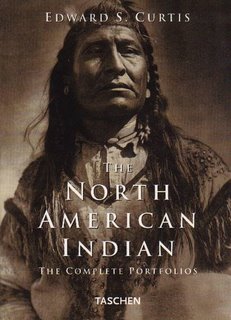


With a sense of great urgency, Edward Sheriff Curtis (1868-1952) set out around 1900 to create his epic photographic and written record of eighty American Indian tribes. The project took Curtis more than thirty years to complete, cost one and a half million dollars, and ruined his finances, his marriage and his health. The resulting twenty portfolios of large-scale photogravures accompanied by twenty illustrated text volumes -- over 2,200 photographs in all -- were published between 1907 and 1930, and comprise a record of native American life and customs at once beautiful, compelling and disquieting.
Curtis’ photographs are suffused with nostalgia for the vast frontier of the American West, which he and his contemporaries knew would soon vanish. He wrote in his introduction to the study: "The passing of every old man or woman means the passing of some tradition, some knowledge of sacred rites possessed by no other; consequently the information that is to be gathered...respecting the mode of life of one of the great races of mankind, must be collected at once or the opportunity will be lost for all time."
Curtis has been criticized for romanticizing an idealized Indian way of life, while ignoring the very real plight of the native tribes he went to photograph. In fact, he was an outspoken critic of government policies, which by this time had forced Indians to relinquish vast tracts and restricted them to reservations. It is true that Curtis posed his subjects in archaic or ceremonial garments they did not ordinarily wear, and supplied wigs to disguise 20th-century haircuts. He also photographed his subjects in activities they no longer practiced, as warriors for example. He excluded or removed details from his photographs that betrayed evidence of acculturation, and retouched his negatives to make his prints more aesthetically appealing. Despite these devices, Curtis’ works give us a glimpse, however fleeting, of the heroes of Indian resistance, such as of the Lakota (Sioux) chief, Red Cloud, or of the aged Hopi potter who continues her traditional way of life in the face of great change.
Um comentário:
Edward Curtis in motion picture. The Indian Picture Opera. On Amazon.
Postar um comentário